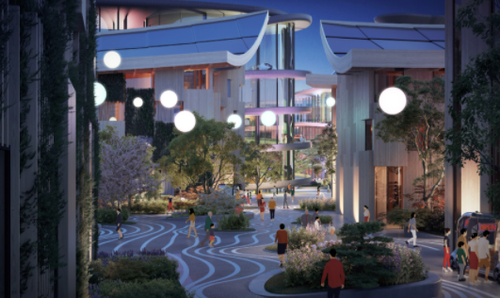Toyota Is Building Its Own Autonomous City Next To Mount Fuji
Many auto executives have said the “missing link” for autonomous success has been cities being wired to funnel data to cars for them to be able to meaningfully drive themselves. So Toyota, the world’s largest automaker, is now setting its sights on building an all-autonomous city.
Toyota President Akio Toyoda kicked off the idea by gathering with Shinto priests at the base of Mount Fuji and praying for success. At an area where the company recently shuttered a factory, the automaker’s focus has turned to the idea of a 175-acre community to test future technologies such as autonomous vehicles, according to Bloomberg.
Toyoda said: “It’s a new chapter in our story and in our industry.”
Toyota is calling it the “Woven City” and it’ll be located about a 2 hour drive from Tokyo. The city will hand pick its residents and will test not only autonomous vehicles, but autonomous deliveries and mobile shops. Construction is expected to be completed in 2024.
Hiroki Kuriyama, senior vice president of Nippon Telegraph and Telephone Corp., has said that cities feeding cars information will be the “the next big leap forward” for autonomous. His company is partnering with Toyota to develop the technology needed for the city.
Kuriyama notes that sensors and cameras built into infrastructure – and possibly even data from mobile phones – will make it easier to gather data that can then be “processed via optical networks” before being fed to cars, allowing them to navigate safely.
Toyota announced this week is was buying Lyft’s autonomous self-driving operations for $550 million. As a result of that deal, Toyota will take on 300 new employees and will ascertain tons of data that Lyft has already collected.
James Kuffner, Toyota’s chief digital officer and head of Woven Planet said the combination “can create a scalable solution that brings mobility beyond what we’re seeing today.” He continued: “Woven City will allow us to try out different city infrastructure. If cars and cities can communicate with each other in a smart way, I think we can build safer systems.”
The city will also feature smart homes that take on their own trash and restock their own refrigerators. The city’s ecosystem will be powered by hydrogen.
Nakanishi Research Institute head Takaki Nakanishi said: “Mobility, living and cities are going to become connected, and control of that standardized software, that’s what everyone wants.”
Kuriyama is confident the technology being used in the Woven City will be available within 5 to 10 years. “But what’s important is whether residents living in other cities will welcome those technologies,” he said.
Alexander Soley, an independent consultant focusing on autonomous vehicles, said: “When it comes to new technologies, you can’t just release them and expect them to get picked up, they need to sit with people for a good period of time.”
“Elderly families are a group targeted to live in the city. How will they feel about stepping foot in a car without a driver? That’s what Toyota’s trying to figure out,” he continued.
The town is going to house about 360 visiting scientists, Toyota employees, families and retirees. That number will eventually push into the thousands. The estimate costs is “upwards of a billion dollars” to build the city.
Tyler Durden
Fri, 04/30/2021 – 19:20![]()
Zero Hedge’s mission is to widen the scope of financial, economic and political information available to the professional investing public, to skeptically examine and, where necessary, attack the flaccid institution that financial journalism has become, to liberate oppressed knowledge, to provide analysis uninhibited by political constraint and to facilitate information’s unending quest for freedom. Visit https://www.zerohedge.com


